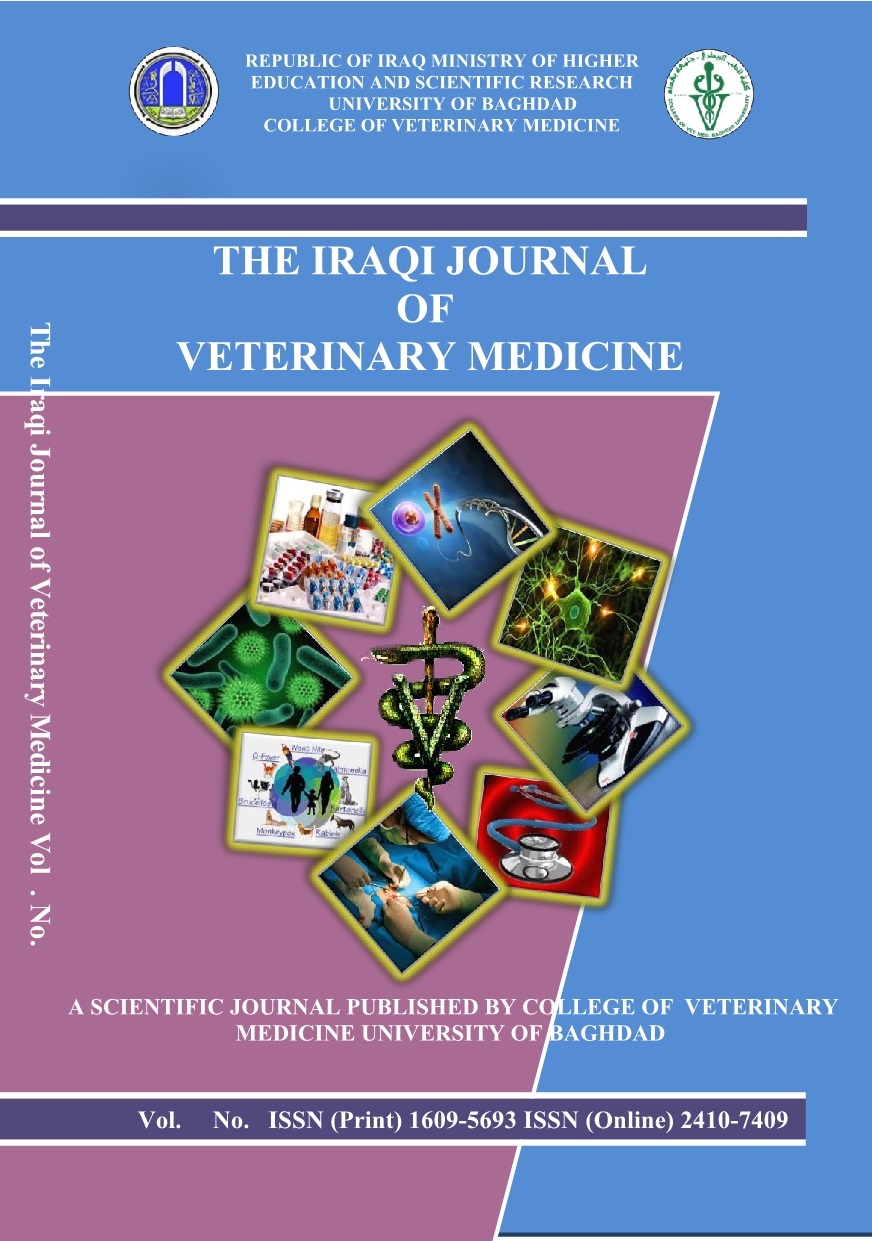Abstract
This study was designed to investigate the bacterial species that induce upper and lower respiratory tract infection in sheep, and to find out any relationship which may exist between them.
Therefore two groups of sheep were employed. The first group was suffering from certain respiratory signs. While the second group was apparently healthy. Each group included 50 sheep. Research samples were collected for a period of six months from AL-Shulla Abattoir.
Microbiological investigation indicated the isolation of certain microorganisms from all animals in both groups from nasal cavity, and from 34 lungs of the first group and 16 lungs of the second group. The number of isolates from the nasal cavity, were 200 from different species ,43 isolates from the bronchioles and 70 from the lungs tissue. On the other hand the number of bacterial isolates from the nasal cavity, bronchioles and the lung tissue of the first group were 113, 29 and 55 respectively.
The study revealed the isolation of potentially pathogenic bacteria from the lower respiratory system of both groups, these bacteria were namely Pasteurella haemolytica of serotype (A2), Niesseria spp. and Corynebacterium pyogenes, the number of isolates were 6 for each, and 8 isolates of Staphylococcus aureus. These bacteria were also isolated from the nasal cavity. The isolation of these bacteria from the nasal strongly suggested their presence in the lungs and the probable role in lesion formation.
Animal inoculation were performed to study the virulence of P. haemolytica which caused certain hemorrhagic lesion in the lung , liver and kidney, with areas of necrosis in the lungs of the experimentally inoculated rabbit, and caused death in mice. While the inoculation of C. ovis caused the death of rabbits within 72 hours, together with the presence of multiple abscessation on the internal organs and abdomenal wall.
Sensitivity tests indicated a high sensitivity of most isolates to Gentamicin, Erythromycin and Kanamycin.
Therefore two groups of sheep were employed. The first group was suffering from certain respiratory signs. While the second group was apparently healthy. Each group included 50 sheep. Research samples were collected for a period of six months from AL-Shulla Abattoir.
Microbiological investigation indicated the isolation of certain microorganisms from all animals in both groups from nasal cavity, and from 34 lungs of the first group and 16 lungs of the second group. The number of isolates from the nasal cavity, were 200 from different species ,43 isolates from the bronchioles and 70 from the lungs tissue. On the other hand the number of bacterial isolates from the nasal cavity, bronchioles and the lung tissue of the first group were 113, 29 and 55 respectively.
The study revealed the isolation of potentially pathogenic bacteria from the lower respiratory system of both groups, these bacteria were namely Pasteurella haemolytica of serotype (A2), Niesseria spp. and Corynebacterium pyogenes, the number of isolates were 6 for each, and 8 isolates of Staphylococcus aureus. These bacteria were also isolated from the nasal cavity. The isolation of these bacteria from the nasal strongly suggested their presence in the lungs and the probable role in lesion formation.
Animal inoculation were performed to study the virulence of P. haemolytica which caused certain hemorrhagic lesion in the lung , liver and kidney, with areas of necrosis in the lungs of the experimentally inoculated rabbit, and caused death in mice. While the inoculation of C. ovis caused the death of rabbits within 72 hours, together with the presence of multiple abscessation on the internal organs and abdomenal wall.
Sensitivity tests indicated a high sensitivity of most isolates to Gentamicin, Erythromycin and Kanamycin.
Abstract
لقد صممت هذه الدراسة لمعرفة الجراثيم التي تؤثر على الجهاز التنفسي العلوي والسفلي ومدى العلاقة بينهما في مجموعتين من الاغنام ، المجموعة الاولى تعاني من اعراض تنفسية والمجموعة الثانية سليمة ظاهرياً. تضمنت كل مجموعة 50 حيواناً وجمعت عينات البحث على مدى ستة اشهر من مجزرة الشعلة في بغداد . وتمكنا من عزل الجراثيم من جميع حيوانات الدراسة من التجويف الانفي كما تم عزلها من 34 رئة من الحيوانات المريضة ومن 16 رئة من الحيوانات السليمة ظاهرياً. وبلغ عدد العزلات الجرثومية من التجويف الانفي 200 عزلة ومن القصيبات 43 ومن النسيج الرئوي 70 عزلة وعزلت من الانف والقصيبات والنسيج الرئوي في الحيوانات المريضة 113 ،29،55، جرثومة على التوالي.
من اهم هذه العزلات من الرئة الباستوريلا هيمولتكا(Pasteurella haemolytica) من النمط المصلي (A2)، النايسيريا (Niesseria spp.) والوتديات القيحية (Corynebacterium pyogenes) وبلغ عددها 6 لكل منها و8 عزلات من المكورات العنقودية الذهبية وقد اقترن عزل الجراثيم المذكورة اعلاه من التجويف الانفي لكلا المجموعتين.
أحدثت الباستوريلا نزف في كل من الرئة والكبد والكلية مع تنخر في الرئة عند حقنها تجريبياً في الارنب وهلاك الفئران عند حقنها . اما الوتديات الضانية فقد أهلكت الارنب خلال 72 ساعة مع وجود خراجات عديدة في الأحشاء الداخلية وجدار البطن .
أظهرت فحوصات الحساسية للمضادات الحياتية كفاءة الجنتامايسين والارثرومايسين والكانامايسين ضد جميع العتر المعزولة .
من اهم هذه العزلات من الرئة الباستوريلا هيمولتكا(Pasteurella haemolytica) من النمط المصلي (A2)، النايسيريا (Niesseria spp.) والوتديات القيحية (Corynebacterium pyogenes) وبلغ عددها 6 لكل منها و8 عزلات من المكورات العنقودية الذهبية وقد اقترن عزل الجراثيم المذكورة اعلاه من التجويف الانفي لكلا المجموعتين.
أحدثت الباستوريلا نزف في كل من الرئة والكبد والكلية مع تنخر في الرئة عند حقنها تجريبياً في الارنب وهلاك الفئران عند حقنها . اما الوتديات الضانية فقد أهلكت الارنب خلال 72 ساعة مع وجود خراجات عديدة في الأحشاء الداخلية وجدار البطن .
أظهرت فحوصات الحساسية للمضادات الحياتية كفاءة الجنتامايسين والارثرومايسين والكانامايسين ضد جميع العتر المعزولة .
